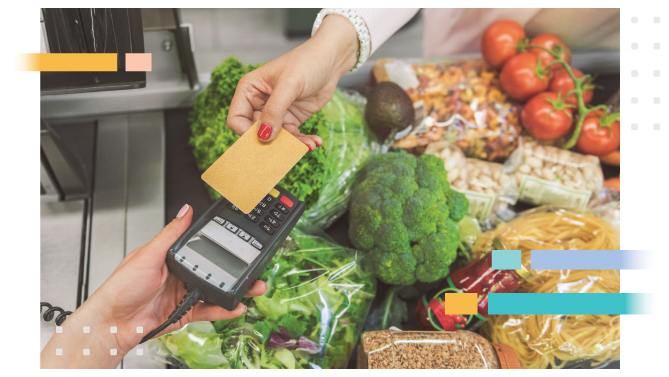Can You Get a Tax Receipt When Donating at the Grocery Store?
July 23, 2024
6 min read
You’re in line at the grocery store checkout, waiting for the cashier to ring up your purchases when suddenly you’re asked: “Would you care to contribute $2 to charity today?”
This fundraising tactic, where customers are asked to donate at checkout, is known as point-of-sale (POS) fundraising. While it’s a convenient and easy way to solicit small donations from shoppers, there are some obvious drawbacks to this method of giving, such as donors not receiving a tax receipt for their donations. Being asked to donate on the spot can also make you feel pressured into donating to a cause you do not fully support, care for, or know about.
So is there a more effective way to donate? Let’s explore some of the pros and cons of point-of-sale fundraising and how you can take control of your charitable donations through a free Impact Account.
What is point-of-sale fundraising?
Point-of-sale fundraising is a fundraising method where customers are asked to make a small donation (i.e. $1, $2, $5 or a custom amount) to a charitable cause during the checkout process, either in a physical store or online. If you agree, the amount will then be added to your total bill. The retailer then forwards the donations to the designated charity or cause.

The benefits of point-of-sale fundraising
Quick and convenient
One of the primary reasons to donate at the grocery store is convenience. This type of giving doesn’t require extra effort or planning, making it a quick and accessible way for shoppers to contribute small amounts to charitable causes.
Small donations that add up
Even small contributions can create a significant impact when many shoppers decide to donate. When thousands of shoppers each contribute a few dollars, it can add up to a substantial amount. Small donations are also easier to manage when added to a bill, which could incentivize shoppers to donate more frequently at the checkout.
Greater awareness
Point-of-sale donations at grocery stores could potentially help increase awareness about specific causes and charities when it’s done in a high-traffic environment. Large retailers typically have a higher volume of shoppers, so a routine ask to donate at the checkout can be an effective way to reach a broader audience on specific causes.
The drawbacks of point-of-sale fundraising
No tax receipts or benefits
When you donate at the grocery store, the store shouldn’t get the tax receipt because they are not the true donor. The tax receipt should go to the person who donated the money and the store is only collecting donations on behalf of the charity. To receive a tax receipt from the charity, you would need to provide detailed personal information such as your full name and address at the checkout, which is not feasible when there are other shoppers behind you in line. Without a tax receipt, you miss out on potential tax deductions and credits. Over time, these missed deductions can add up, especially if you donate frequently.
Pre-selected organizations
Grocery stores usually partner with specific, often large, charities for their fundraising campaigns. While these organizations do important work, this limits your ability to choose where your money goes. You may prefer to support a different charity or cause you care more about that’s not featured by the store.
Overshadowing smaller charities
Larger, well-known charities tend to dominate grocery store fundraising efforts. This can overshadow smaller, grassroots organizations that also need support. According to the Canada Revenue Agency (CRA), there are more than 86,000 registered charities in the country. A report from Imagine Canada found that smaller charities, with revenues under $500,000, make up 80% of all registered charities in Canada, yet they receive less funding than larger, well-funded, organizations.
Lack of informed giving
Donating at the grocery store checkout is often a spur-of-the-moment decision. This doesn’t allow for thorough research or understanding of the charity’s mission, impact, and use of funds. Informed giving ensures that your donations align with your values and support the causes you care about.
Pressured into giving
The social pressure to donate at the checkout can lead to hasty decisions. You might feel obligated to give because of the cashier’s request or the presence of other customers behind you in line, rather than a genuine desire to support a specific charity. Donations made under pressure can feel more like an obligation than a voluntary, intentional, and purposeful act of giving.
Planned giving v.s. the pressure to give
Donating at the checkout can often make donors feel pressured or rushed. When donors become fatigued by the sudden and constant request to give, they might decide to opt out of future giving and charitable transactions altogether. At Charitable Impact, we believe that donors who give for their own reasons and to the charities of their choice are the happiest. Happy donors are more likely to keep giving, creating a greater impact over time.
A more effective way to give through an Impact Account
With Charitable Impact’s free Impact Account, you can create a personal giving fund that gives you greater control and flexibility over how you want to give, including getting downloadable tax receipts all in one place right when you donate, so you’ll never lose a receipt again. Manage all your donations from the account, support one charity or several from among the 86,000 Canadian registered charities, and start Giving Groups to pool your contributions with friends, family, colleagues, or others who share your charitable goals. Learn more about Impact Accounts today and how you can make a difference through planned giving.
